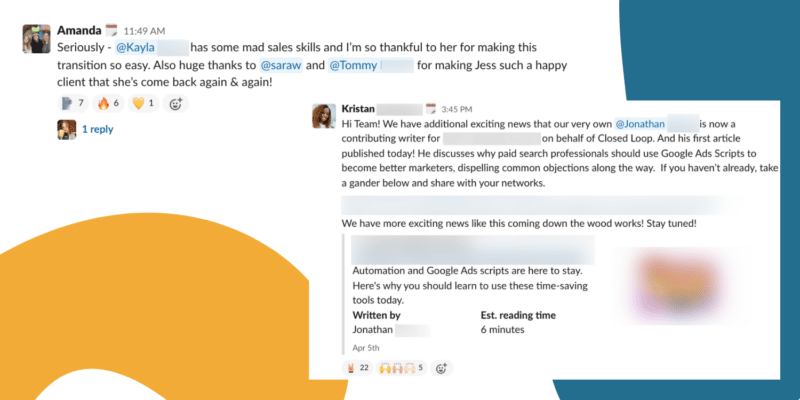How to retain employees during the Great Resignation

How do you retain skilled employees during The Great Resignation? The solution is grounded in building a culture of trust.
The last thing an agency leader wants to deal with is seeing their strongest employees go elsewhere.
So, how do you retain skilled employees during The Great Resignation? The solution is grounded in building a culture of trust.
How to build a culture of trust
You’ve invested countless hours interviewing, onboarding and training your employees.
On the job, they’ve proven themselves to be strong performers.
You’ve also provided them with the tools and resources to succeed.
And yet, countless agencies are run by leaders that micromanage their employees.
It’s time to trust them to do their job and get out of their way.
Here’s how:
- Get everyone on the same page: Be open about what you’re trying to accomplish, your vision and how employees play a part in that vision. The idea here is to get everyone rowing in the same direction.
- Encourage transparency: Building a culture of trust cannot happen without openness. We encourage our employees to be open and transparent about their feelings, and our managers to do the same. Leadership is transparent about company performance and plans for the organization. This transparency infuses a sense of ownership and respect throughout the organization.
Appreciate and recognize your employees
Nothing will burn out a good employee faster than feeling underappreciated.
Appreciation can come in many forms, including a quick thank you, promotion or salary increase.
Recognition can be public or private, and it should come from any level within the organization.
Here’s how my agency approaches appreciation and recognition:

Peer recognition program
Bonus.ly has been a great addition to our company’s culture.
Each month, employees have a specific number of points that can be used to recognize peers.
Points are accumulated and redeemed through gift cards to restaurants, shops, entertainment, charity donations or cold hard cash.
The Slack integration makes it easy to see who is recognizing who.

Leadership recognition
Peer recognition is wonderful, but employees also need to know that they’re making a real impact on the company. This is where leadership recognition comes in.
Publically, we recognize employees who contribute to the bottom line through company meetings or internal case studies.
This public recognition serves to show appreciation to the employee but also helps to encourage others to achieve similar feats.

How to build connections between employees
The Institute of Leadership and Management found that 77% of respondents say that building close relationships with colleagues was the most important factor in determining job satisfaction.
Connection is critical in building a culture of trust and ultimately retaining great employees. In a remote workplace, this is especially important.
We’ve found three ways to help build connections between employees:
- Make time for connection: Take the time to connect with employees on a personal level. Building rapport is essential when things are busy. This signals to your employees that even amidst the chaos, they’re still important to you. So, make time during 1:1s to learn about employees and tell them about yourself.
- Enjoy your colleagues: As a primarily remote company, this takes some effort. We regularly use apps like Kahoot for fun quizzes, ice breaker challenges and Polly for polls on Slack.
- Encourage sharing of expertise: Embedded within our culture is both a strong motivation to get better and to support one another. We foster both by sharing our expertise. Employees will create brown bag training sessions taught by various team members. Managers will also often encourage team members to ask questions broadly on Slack. As a result, questions have quick answers and employees are reminded that team support is valued.
Also, make sure to post pictures of team members meeting each other and having a good time.

Offer flexibility and grace
Always remember that you’ve hired people, not just “workers.”
Work is just one facet of their lives. Burnout in our industry is very real.
Take care to ensure your best employees flourish. To retain great employees, offer flexibility and grace.
Here’s how we do that:
- Daily flexibility: Allow some flexibility within the workday for employees to take care of what they need. We regularly have employees that need to pick up their kids, take the dog to the vet or even go for a jog. We’ve found that providing this flexibility enables employees to perform at their best and be more productive.
- Encourage time off: We saw many of our employees not taking time off during the pandemic. They felt like there was no point because they couldn’t go anywhere. What resulted was decreased productivity and overall gloom within the organization. To turn things around, we encouraged employees to take time off. We implemented an unlimited vacation policy so people didn’t feel like they were “wasting” vacation days. And managers noted when an employee hadn’t taken time off.
- Create backups: One of the concerns in taking time off is the fear that the work will pile up. That’s why we created a system for employees to partner with other employees to act as backups while they’re out. With the backup plans in place, employees are truly “off” when on vacation.
- Allow for grace: Throughout the pandemic, we’ve had to allow some grace for employees dealing with circumstances in their lives that impact work. Everyone goes through stressful events, and its not reasonable to think it won’t affect work. We allow some grace for productivity to decline, work hours to be shortened or additional time off for employees dealing with “life.”
Build the workplace where you’d like to work
This is how you retain great employees. Trust, appreciation, connection and flexibility are the tenets of a strong culture. But they also happen to be the key to retaining great employees.


